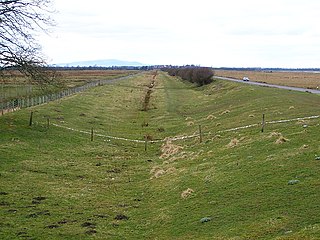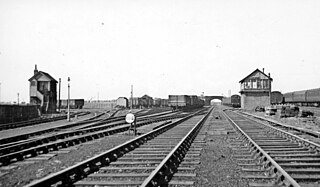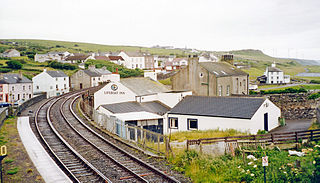
Silloth was the terminus of the Carlisle and Silloth Bay Railway, a branch railway from Carlisle, England. The town, dock and station at Silloth were built on a greenfield site after the Carlisle & Silloth Bay Railway & Dock Act (1855) was passed. The railway provision grew with the dock and its later additions.

Abbey Town railway station was on the branch line off the Solway Junction Railway in the English county of Cumberland. The first station after Abbey Junction on the branch to Silloth on the Solway Firth, it served the village of Abbey Town. The station closed with the line to Silloth in 1964.

Great Broughton railway station briefly served the village of Great Broughton, near Cockermouth in Cumberland, England.
There were two interlinked railways on the south shore of the Solway Firth.

Seaton railway station served the village of Seaton, near Workington in Cumberland, England.

Port Carlisle railway station was a railway station in Port Carlisle, Cumbria; the terminus on the Port Carlisle Railway, serving the village and old port and the steamer service to Liverpool that ran from here until 1856, when it was transferred to Silloth. Port Carlisle was two and a half miles away by train from Drumburgh and Glasson was one and a quarter miles away. The journey time to Drumburgh was nine minutes, although Glasson was a request stop.

Glasson railway station was a railway station in Glasson, Cumbria, England. It was the last station before the terminus on the Port Carlisle Railway branch, serving the small village of that name. Nothing now remains of the station.

Drumburgh railway station was near the village of Drumburgh, Cumbria, England.

Burgh-by-Sands railway station was originally named Burgh. It opened in 1854 on the Port Carlisle Railway branch and later the Silloth branch, serving the village of Burgh in Cumberland - now Cumbria - England. The line and station closed on 7 September 1964 as part of the Beeching cuts.

Bromfield was a railway station which served Bromfield, a small settlement in Cumbria on the English side of the Solway Firth. The station opened in 1873 by the Caledonian Railway on a line constructed from the Caledonian Railway Main Line at Kirtlebridge across the Glasgow South Western Line, then forming the Solway Junction Railway over the Solway Viaduct to Brayton. The line opened for freight trains on 13 September 1869.

The B5302 is a B road which runs for approximately twelve-and-a-quarter miles between the towns of Silloth-on-Solway and Wigton in Cumbria, United Kingdom. From west to east, it passes through the villages of Causewayhead, Calvo, Abbeytown, Wheyrigg, and Waverbridge, and also passes near to Blackdyke and Blencogo. At its eastern end, it comes very close to the Solway Coast Area of Outstanding Natural Beauty, and passes by Silloth Airfield, left over from the Second World War. Several of the villages that the road passes through were formerly served by trains on the single-track Carlisle and Silloth Bay Railway, which closed with the Beeching axe in the 1960s. It is the main road connecting Silloth-on-Solway and surrounding settlements with the A596, and by extension, the city of Carlisle.

Harrington Junction was a railway junction in Harrington, Cumbria, England. It joined three branches to the Cleator and Workington Junction Railway's (CWJR) main line from Workington Central to Moor Row via Cleator Moor West. No station ever existed at the junction, High Harrington was the nearest, 48 chains (0.97 km) to the south.

Harrington railway station, or Church Road halt, was a railway station in Harrington, Cumbria, England. It was opened by the Cleator and Workington Junction Railway (C&WJR) on the company's Harrington Branch which connected with the Lowca Light Railway at Rosehill to provide a through route from Lowca to Workington Central and beyond.

Rosehill railway station was opened by the Cleator and Workington Junction Railway (C&WJR) on the company's Harrington Branch which connected with the Lowca Light Railway (LLR) at Rosehill to provide a through route from Lowca to Workington Central and beyond.

Camerton Colliery Halt railway station was an unadvertised halt for workers at one or both of the collieries at Camerton, near Cockermouth in Cumberland, England.

Buckhill Colliery Halt railway station was an unadvertised halt for workers at Buckhill Colliery north east of Camerton, near Cockermouth in Cumberland, England.

Copperas Hill railway station served the small clifftop community of Copperas Hill, south of Harrington in the former county of Cumberland, England, which is now part of Cumbria.

Cumberland and Westmorland Convalescent Institution railway station was a terminus off the short Blitterlees Branch off the Carlisle and Silloth Bay Railway, within Silloth itself. The larger railway ran from Carlisle, England. The station does not appear on standard railway maps, but it can be discerned with a magnifying glass on at least two published maps and clearest of all on the 1914 25" OS map.
Silloth Battery Extension railway station was the terminus of the Blitterlees Branch, which turned southwards off the Carlisle and Silloth Bay Railway's Silloth Branch a short distance east of Silloth station. The larger railway ran from Carlisle, England. The Bitterlees Branch does not appear on standard railway maps, but it is clear on OS maps, though the station is not identifiable as such.
Carlisle Canal railway station was opened in 1854 as the Carlisle terminus of the Port Carlisle Railway Company's line from Port Carlisle in Cumbria, England. That line was largely laid along the course of the Carlisle Canal, hence the station's name.
















